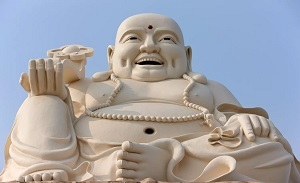Five Odd Facts About Buddhism
 Five Odd Facts About Buddhism
Five Odd Facts About Buddhism
Although there have been Buddhists in the West for at least a couple of centuries, it's been only relatively recently that Buddhism has had any impact on Western popular culture. For this reason, Buddhism is still relatively unknown in the West.
And there's a lot of misinformation out there. If you cruise around the Web, you can find many articles with titles like "Five Things You Didn't Know About Buddhism" and "Ten Weird Facts About Buddhism" These articles often are riddled with errors themselves. (No, Mahayana Buddhists do not believe the Buddha flew into Outer Space.)
So here is my own list of little-known facts about Buddhism. However, I cannot tell you why the Buddha in the photo seems to be wearing lipstick, sorry.
1. Why Is Buddha Fat Sometimes and Skinny Sometimes?
I found a couple of online "FAQs" say that say, incorrectly, that the Buddha started out fat but became slender by fasting. No. There are more than one Buddha. The "fat" Buddha began as a character from Chinese folk tales, and from China his legend spread throughout east Asia. He is called Budai in China and Hotei in Japan. In time the Laughing Buddha came to be associated with Maitreya, the Buddha of the future age.
Siddhartha Gautama, the man who become the historical Buddha, did practice fasting before his enlightenment. He decided that extreme deprivation wasn't the way to Nirvana. However, according to early scriptures, the Buddha and his monks ate only one meal a day. That might be considered a half-fast.
2. Why Does the Buddha Have an Acorn Head?
He doesn't always have an acorn head, but yes, sometimes his head resembles an acorn. There's a legend that the individual knobs are snails that voluntarily covered the Buddha's head, either to keep it warm or cool it off. But that's not the real answer.
The first images of the Buddha were created by artists of Gandhara, an ancient Buddhist kingdom located in what is now Afghanistan and Pakistan. These artists were influenced by Persian, Greek and Roman art, and they gave the Buddha curly hair tied into a topknot (here's an example). This hairdo apparently was considered stylish at the time.
Eventually, as Buddhist art forms moved into China and elsewhere in east Asia, the curls became stylized knobs or snail shells, and the topknot became a bump, representing all the wisdom in his head.
Oh, and his earlobes are long because he used to wear heavy gold earrings, back when he was a prince.
3. Why Aren't There Any Women Buddhas?
Sculptures of Guanyin, Goddess of Mercy, are displayed in the bronze factory at Gezhai Village in Yichuan County of Henan Province, China. Photo by China Photos/Getty Images
The answer to this question depends on (1) whom you ask, and (2) what you mean by "Buddha."
In some schools of Mahayana Buddhism, "Buddha" is the fundamental nature of all beings, male and female. In a sense, everyone is Buddha. It's true that you can find a folk belief that only men enter Nirvana expressed in some later sutras, but this belief was directly addressed and debunked in the Vimalakirti Sutra.
In Theravada Buddhism, there is only one Buddha per age, and an age could last millions of years. Only men have had the job so far. A person other than a Buddha who achieves enlightenment is called an arhat or arahant, and there have been many women arhats.
4. Why Do Buddhist Monks Wear Orange Robes?
A monk poses on a beach in Cambodia. © Brian D Cruickshank / Getty Images
They don't all wear orange robes. Orange is most commonly worn by Theravada monks in southeast Asia, although the color can vary from burnt orange to tangerine orange to yellow-orange. Chinese nuns and monks wear yellow robes for formal occasions. Tibetan robes are maroon and yellow. Robes for monastics in Japan and Korea are often grey or black, but for some ceremonies they may don a variety of colors. (See The Buddha's Robe.)
The orange "saffron" robe of southeast Asia is a legacy of the first Buddhist monks. The Buddha told his ordained disciples to make their own robes out of "pure cloth." This meant cloth no one else wanted.
So the nuns and monks searched charnel grounds and rubbish heaps for cloth, often using cloth that had wrapped decaying corpses or had been saturated with pus or afterbirth. To be made usable the cloth would be boiled for some time. Possibly to cover stains and odors, all kinds of vegetable matter would be added to the boiling water -- flowers, fruits, roots, bark. Leaves of the jackfruit tree -- a type of fig tree -- were a popular choice. The cloth usually ended up some mottled spice color.
What the first nuns and monks probably did not do was die the cloth with saffron. It was expensive in those days, too.
Note that these days the monks of southeast Asia make robes from donated cloth..
5. Why Do Buddhist Monks and Nuns Shave Their Heads?
Because it's a rule, possibly instituted to discourage vanity and promote good hygiene. See Why Buddhist Monks and Nuns Shave Their Heads.
By Barbara O'Brien
https://www.learnreligions.com/

